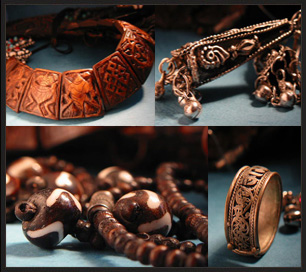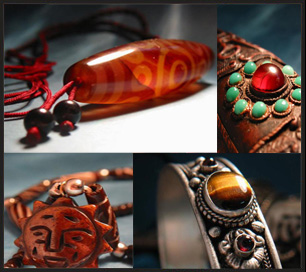|
tibetan lotus, tibetan lotus flower , tibet lotus, tibetian lotus, tibetian snow lotus, buddhist lotus, om mani padme hum lotus, buddhism lotus, buddha lotus, buddha lotus, lotus jewelry
Tibet Artwork, Tibetan Silver Jewelry , Tibetan Jewelry, Tibet Jewelry, Jewelry from Tibet, Tibetan Buddhist Jewelry, Tibetan Turquoise Jewelry, Tibetan Jewelery, Buddhist Jewelry
|
|
The lotus is one of Buddhism's best recognized motifs and appears in all kinds of Buddhist art across all Buddhist cultures. Scrolling lotuses often embellish Buddhist textiles, ceramics and architecture.
Every important Buddhist deity is associated in some manner with the lotus, either being seated upon a lotus in full bloom or holding one in their hands. In some images of standing Buddhas, each foot rests on a separate lotus.
The lotus does not grow in Tibet and so Tibetan art has only stylized versions of it, yet it appears frequently with Tibetan deities and among the Eight Auspicious Symbols.
The color of the lotus has an important bearing on the symbology associated with it:
- White Lotus (Skt. pundarika; Tib. pad ma dkar po): This represents the state of spiritual perfection and total mental purity (bodhi). It is associated with the White Tara and proclaims her perfect nature, a quality which is reinforced by the color of her body.
- Pink Lotus (Skt. padma; Tib. pad ma dmar po): This the supreme lotus, generally reserved for the highest deity. Thus naturally it is associated with the Great Buddha himself.
- Red Lotus (Skt. kamala; Tib: pad ma chu skyes): This signifies the original nature and purity of the heart (hrdya). It is the lotus of love, compassion, passion and all other qualities of the heart. It is the flower of Avalokiteshvara, the bodhisattva of compassion.
- Blue Lotus (Skt. utpala; Tib. ut pa la): This is a symbol of the victory of the spirit over the senses, and signifies the wisdom of knowledge. Not surprisingly, it is the preferred flower of Manjushri, the bodhisattva of wisdom.
--------------------------------------------------------------------------------------------------------
Labels: tibetan lotus, tibetan lotus flower , tibet lotus, tibetian lotus, tibetian snow lotus, buddhist lotus, om mani padme hum lotus, buddhism lotus, buddha lotus, buddha lotus, lotus jewelry
Tibet Artwork, Tibetan Silver Jewelry , Tibetan Jewelry, Tibet Jewelry, Jewelry from Tibet, Tibetan Buddhist Jewelry, Tibetan Turquoise Jewelry, Tibetan Jewelery, Buddhist Jewelry
|
Buddhist Symbols
In the earliest centuries of Buddhism, statues of the Buddha were not used. Instead, Buddhist art consisted of images symbolizing the Buddha and his teachings, such as the lotus, the Wheel of the Law, the Bodhi tree and the Buddha's footprints.
Eventually, the Buddha image became one of the most popular representations in Buddhism, but these early symbols remain important and are frequently used to this day. They are especially important in Theravada Buddhist countries like Sri Lanka and Thailand.
As Buddhism spread, Buddhist symbolism was enriched by the cultures it came into contact with. This is especially true of Buddhism in Tibet, which has developed a rich symbolic tradition. The central symbols of Tibetan Buddhism are the Eight Auspicious Symbols, known in Sanskrit as Ashtamangala (ashta meaning eight and mangala meaning auspicious). The Eight Auspicious Symbols are printed on Tibetan prayer flags, incorporated into mandalas and thangkas, and used in other forms of ritual art. Another important symbol is the Wheel of Life, a symbolic representation of the universe as understood by Tibetan Buddhists.
Other important types of symbolism in Buddhism include colors, especially the five colors of white, yellow, red, blue and green, and symbolic hand gestures called mudras. The articles in this section explore these Buddhist symbols, providing information on their history, meaning and use in Buddhism today. (For an introduction and quick guide to Buddhist colors, see our Chart of Buddhist Color Symbolism.)
|
|

Abhaya Mudra
|

Bhumisparsha Mudra
|
|
|
|
|
|
|
|
|
|
|

Lotus
|
|
|
|
|
|
|
|
|
|
|
|
|
|
|
|
|
|
|
--------------------------------------------------------------------------------------------------------
Labels: Tibetan artwork, tibet artwork, tibetan art, tibetan jewelry, handmade tibetan jewelry, tibetan bracelet, tibetan pendant, tibetan necklace, gau box pendant, tibetan ornament, tibetan statue, tibetan thangkas, tibetan singing bowl, buddhist jewelry, buddhist art
|
|




添加新评论